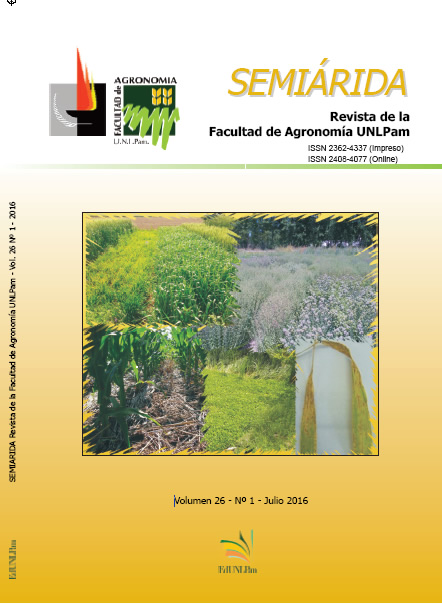Production of different winter crops for the Pampean Semiarid Region
DOI:
https://doi.org/10.19137/semiarida.2016(01).19-24Keywords:
adaptation, alternative crops, bread wheatAbstract
Bread wheat is the most important winter crop in the Pampean Semiarid Region, even under a scenario of high volatility in commodity prices. Other crops such as feed and malting barleys, oats, rye, durum wheat, canarygrass, triticale, rapeseed, safflower and flax can be grown alternatively in that season. The objective of this study was to evaluate the production performance of those alternative winter crops. Tests were conducted in the experimental field of the Agronomy Faculty of the Universidad Nacional de La Pampa (36°32’54” S; 64°18’16” W) on a Petrocalcic Paleoustoll soil. The experiment was run using a randomized complete block design with three replicates, and three dates of sowing were assayed: june 2, june 21 and august 14. Rain falling during the trial period was enough to meet the needs for all the crops, excepting for safflower in December and January. Bread wheat and the two types of barleys sown in the latest date, and triticale sown in the second date, showed the highest grain yield. Oats, feed and malting barleys, rye, durum and bread wheats, and safflower showed their highest grain yield when sown in the third date. The highest performance for canarygrass, triticale and flax was observed for the second date of sowing. The yield of the last ones was lower than that showed by the rest of crops assayed. Therefore, their choosing by the farmer would depend on a view of crop value chain, marketing niche and profitability.
DOI: http://dx.doi.org/10.19137/semiarida.2016(01).19-24
Downloads
References
Allen R., L. Pereira, M. Smith & D. Raes. 1998. Crop evapotranspiration - Guidelines for computing crop water requirements - FAO Irrigation and drainage. FAO - Food and Agriculture Organization of the United. 56: 17-28.
Balzarini M., J. Di Rienzo, M. Tablada, L. González, C. Bruno, W. Robledo & F. Casanoves. 2012. InfoStat profesional versión 2.0.Manual del Usuario, Editorial Brujas, Córdoba, Argentina. 400 p.
Calzada J. & D.S. Corina. 2015. Para sembrar trigo en la campaña 2015/16 habría que invertir 1.500 millones de dólares. En: Informativo semanal. Bolsa Cereales Rosario. pp 5-7. Rosario, Argentina.
Cattáneo M. 2011. Los mercados de cebada cervecera en la Argentina y en el mundo. En: Cebada Cervecera (Eds. Miralles D.J, Benech-Arnold R.L. & L.G. Abeledo). Facultad de Agronomía UBA. pp. 275-284.
Caviglia O.P & F.H. Andrade. 2010. Sustainable Intensification of Agriculture in the Argentinean Pampas: capture and use efficiency of environmental resources. Americas J. Plant Sci. Biotech. 3(1): 1-8.
Caviglia J.A., H.O. Lorda & J.D. Lemes. 2010. Caracterización de las unidades de producción agropecuarias en la provincia de La Pampa. Bol.de Div. Técn. Nº 99. INTA - EEA Anguil, La Pampa, Argentina.
Fernández M.A. 2008. La estabilidad del rendimiento de trigo candeal (Triticum durum Desf.) en la región de las planicies con tosca de la provincia de La Pampa. Rev. Fac. Agron. UNLPam. 19: 41-62.
Ferreira V., E. Grassi, A. Ferreira, H. di Santo, E. Castillo & H. Paccapelo. 2015. Triticales y tricepiros: adaptabilidad e interacción genotipo-ambiente del rendimento en grano. Chilean J. Agric. Anim. Sci. 31: 93-104.
Girola. C. 1915. El cultivo de lino para la producción de semilla en la Argentina (Eds. Cabaut & Cía.). 196 p.
Quiroga A., M. Díaz-Zorita & D.E. Buschiazzo. 2001. Safflower productivity as related to soil water storage and management practices in Semiarid regions. Commun. Soil Sci. Plant 32(17-18): 2851-2862.
SIIA. 2015. Sistema Integrado de Información Agropecuaria. Estimaciones agrícolas. http://www.siia.gov.ar/_apps/siia/estimaciones/.Visitada en Mayo de 2015.
Soil Survey Staff. 1999. Soil taxonomy: a basic system of soil classification for making and interpreting soil surveys Agric. Handbook (2nd ed.), USDA vol. 436, 869 p.
Vergara G.T. & G. A. Casagrande. 2012. Estadísticas agroclimáticas de la Facultad de Agronomía, Santa Rosa, La Pampa, Argentina, 1977-2010. Rev. Fac. Agron. UNLPam. 22: 1-75.
Walkley A & I.A. Black. 1934. An examination of the Dejtjareff method for determining soil matter and a proposed modification of the cromic acid triation method. Soil Sci. 37: 29-38.
Downloads
Published
Issue
Section
License
La Editorial de la Universidad Nacional de La Pampa (EdUNLPam) exigirá a los/as autores/as la firma del siguiente documento:
La EdUNLPam lleva a cabo la publicación del artículo: (Título del Artículo) en SEMIÁRIDA Rev.Fac.Agron UNLPam ISSN 2362-4337 (impresa) ISSN 2408-4077 (en línea), del cual el/los abajo firmantes son autores de una o más partes. En el mismo acto, el/los autores entregan exclusivamente a la EdUNLPam todos sus derechos protegidos por las leyes de propiedad intelectual que rigen en la Argentina para reproducir, publicar, editar, fijar, comunicar y transmitir públicamente en cualquier formato o medio impreso o electrónico, inclusive internet, el artículo enviado a publicación e incluirlo en índices o bases de datos nacionales e internacionales. A cambio, la EdUNLPam entrega a los autores la autorización para la publicación o reimpresión con ines académicos y educativos en cualquier libro o medio de divulgación, con la sola obligación de citar el artículo original publicado en la EdUNLPam. Cada autor acuerda en que el material provisto a la EdUNLPam es un trabajo original, que no ha sido impreso o publicado en cualquier otro medio con anterioridad y que no vulnera derechos de terceros. El Primer autor tendrá la posibilidad de leer y corregir el artículo ya editado como “prueba de galera”, pero si el autor no devolviera esas correcciones de la prueba de galera dentro del tiempo especificado, el proceso de producción y publicación podrá proseguir sin la aprobación del autor. El/los autor/es no recibirán compensación monetaria de la EdUNLPam por el uso del material contenido en este artículo y asumen la responsabilidad de las opiniones vertidas en él.










.png)



22.png)



.jpg)




.jpg)
